Seamanship: Better anchoring - tips and tricks for every situation
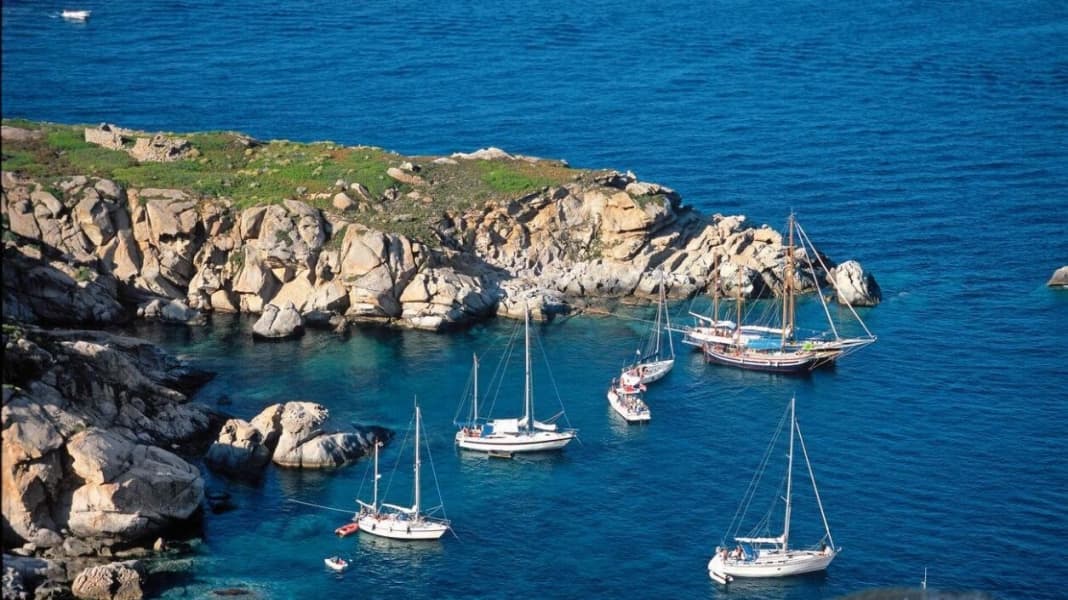
Especially in summer, every skipper is probably familiar with this unpleasant moment: you have chosen a bay for a swim or evening stop, come motoring round the corner full of anticipation and excitement - and then there are already umpteen yachts moored there. A first glance reveals that it will be really tight if you want to stay, but the next bay is miles away. Or a certain restaurant, perhaps a tourist attraction, beckons and the crew is determined to stay.
If it is very crowded, it is important to realise how the other ships and their harnesses are positioned. Neighbours' anchors and chains do not always run in the same direction as their bow, for example if the wind is weak or has shifted and the chains have not yet aligned. Try to recognise as much as possible, even if this is difficult in murky, deeper or choppy water.
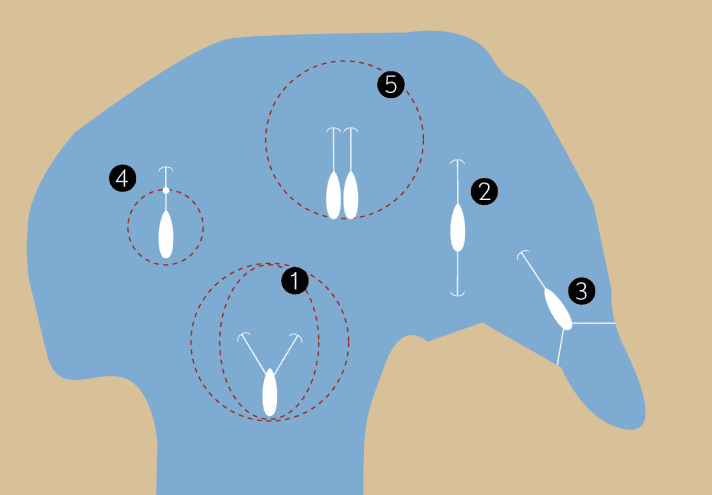
The skipper should also be aware of what to expect during the night: Are wind shifts forecast? Or is a change from land breeze to sea breeze likely? Are squalls to be expected? Of course, forecast weather changes with wind shifts are just as important. The swell that such changes bring with them should also be taken into account, especially if the bay is relatively open and only offers protection in a few wind directions.
Once all these soundings have been carried out thoroughly, it is important to find the right manoeuvre from the possible ones. In terms of good seamanship, this means the manoeuvre that promises the greatest possible safety in the prevailing conditions, while at the same time minimising the proximity to other yachts. Five manoeuvre variants and their advantages and disadvantages.
The anchor V
The forward-mounted second anchor significantly narrows the centre of gravity (red dotted line) and generally reduces the movement of the yacht considerably. The holding power increases enormously. This method is therefore also well suited for strong winds if you no longer fully trust the hold of the main anchor. The closer the angle between the two harnesses approaches 90 degrees, the smaller the centre of gravity. The yacht turns very tightly around the bow and no longer moves back and forth as is often the case with high-sided boats. The disadvantage is that you have to retrieve two harnesses at night in the event of problems and other crews do not always notice the technique with two anchors.
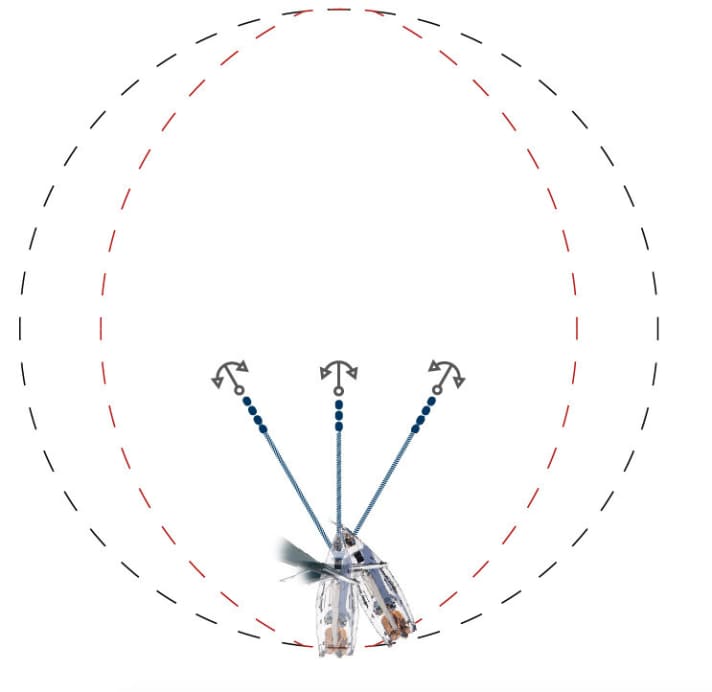
The realisation
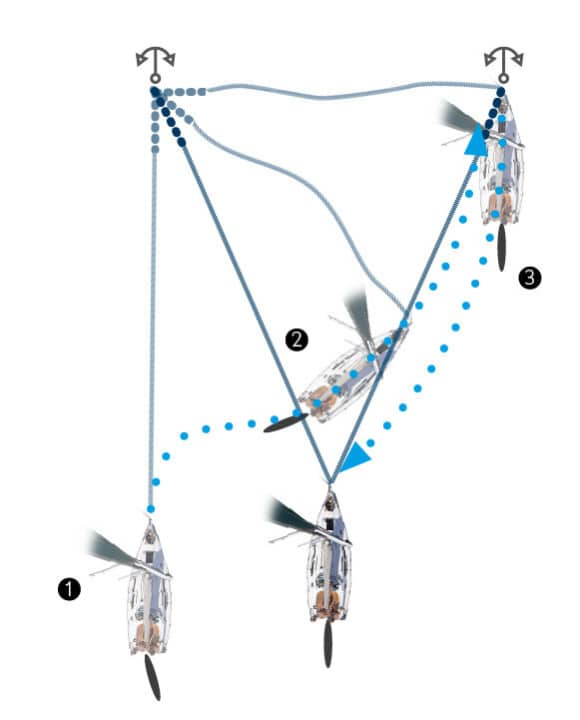
- A normal manoeuvre is carried out with the bow anchor and sufficient chain is put in place; now you can carry out the manoeuvre with the dinghy or engine.Under machine: motor very slightly in the direction of the chain. Then turn diagonally and motor slowly until the anchor is at about the same height as the boat. Important: make sure that there is not too much tension on the chain, otherwise the anchor bow fitting may bend or the first anchor may break out!
- With the dinghy: Row the anchor plus chain leader and rope to the desired location. Anchor to the bottom, chain slowly behind, but do not let it fall onto the anchor! Lower the leader to the bottom; it is almost impossible to row against the chain. Now row against the rope to the boat or connect the yacht to the anchor rope beforehand using a thin safety line, which is already loose when rowing out.
- Once the position is reached, drop the anchor and let the wind push the yacht to leeward. Insert the same amount of chain and rope as for the other anchor. Dig in lightly with the engine.
Rear anchor
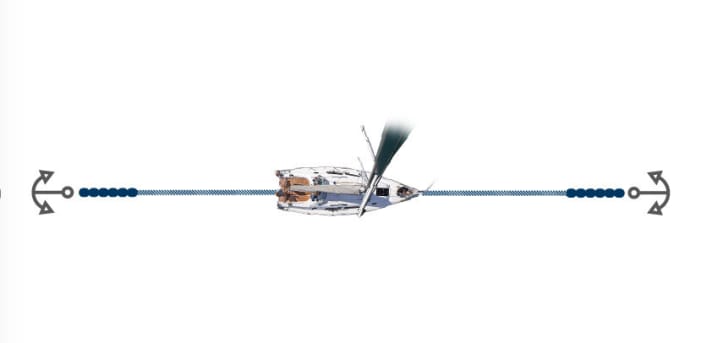
Good for narrow gaps or when the wind shifts. The yacht is placed between two equally spaced bow and stern anchors. The boat later turns almost exclusively around the bow. Sequence: either deploy the bow anchor first and then double the chain as far as necessary. Set the stern anchor and then haul in half of the chain again. Do not haul the stern line at the end so that the winch pulls the stern anchor into the bottom. Alternatively, set the stern anchor first while the bow is in the wind. Then motor forwards to the desired location of the bow anchor and anchor there. Lower both anchors.
Country linen
The best way, because it is the safest solution, is to use narrow gaps. The yacht lies in front of the bow anchor and is fastened ashore with two lines if possible - you are protected against wind shifts, lie absolutely still and can get very close to rocks, flax or neighbours also moored in this way. If a strong wind comes up and the
anchor slips, you can even steam into the stern lines!
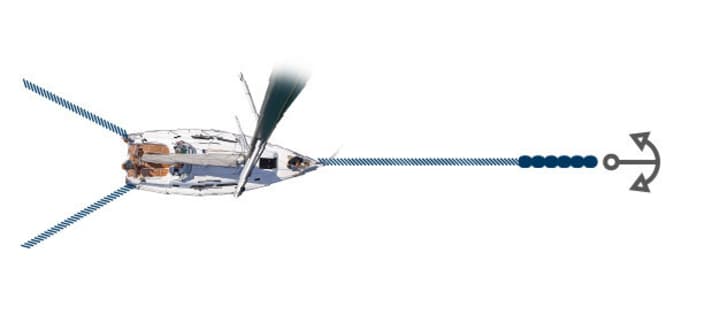
If necessary, a line will often do - but allow enough space in case the wind shifts, as the line slack will then be greater! This is also important for your neighbours: if their shore lines hang slack in the water, they will be pushed far over in the wind. Therefore, make sure the shore lines are sufficiently slack.
This is how the manoeuvre succeeds:
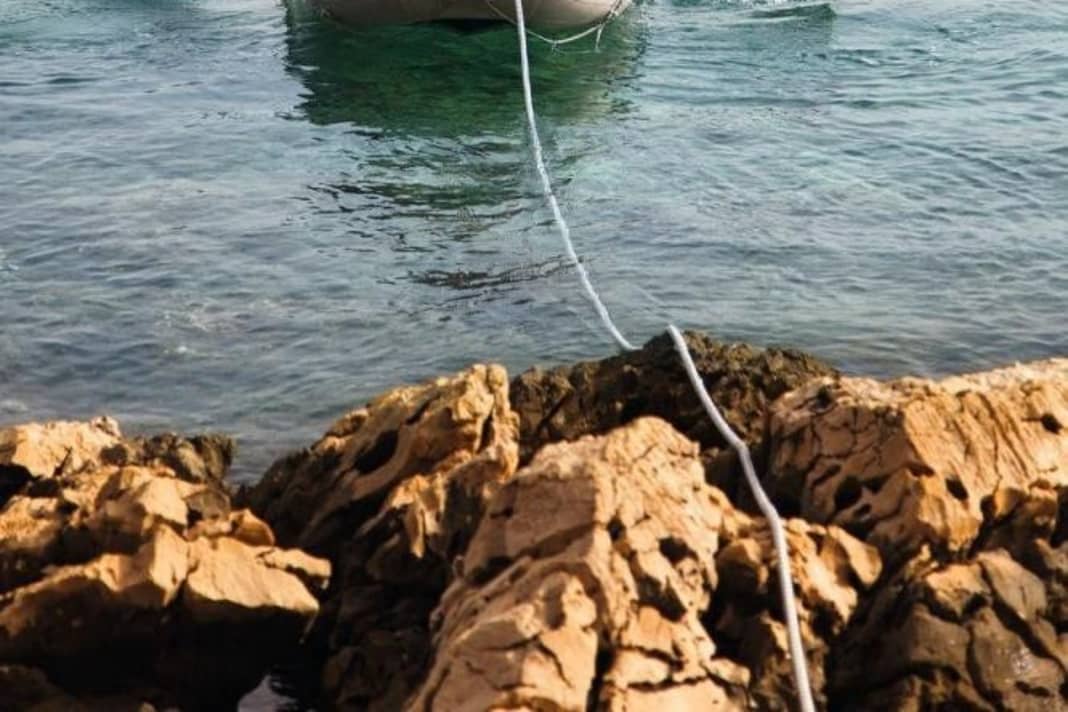



When deploying a shore line, crews often make the mistake of first anchoring and then trying to row out lines that are attached to the stern of the yacht. In doing so, the yacht often drifts sideways onto shallows or neighbouring moorings, or the dinghy man can no longer withstand the weight of the rope in the water. Possible consequence: the manoeuvre is aborted.
Riding weight
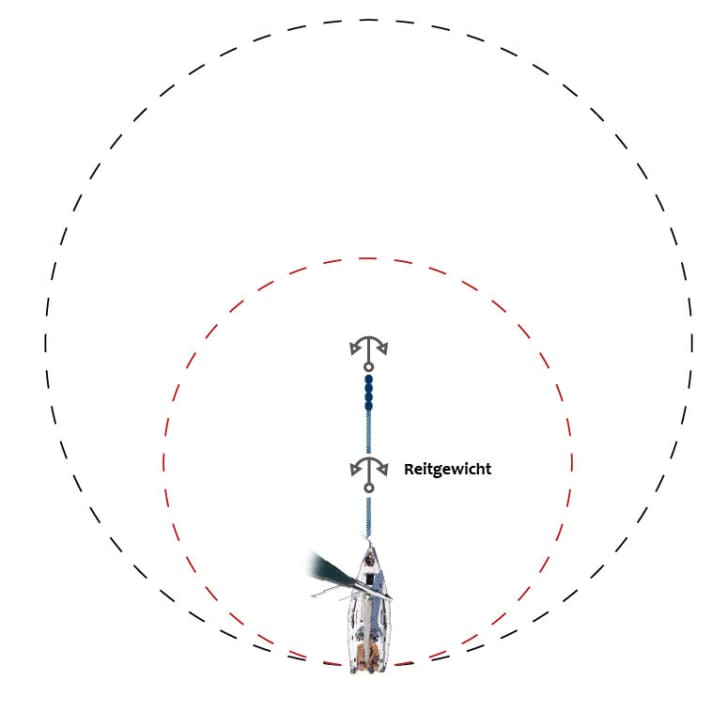
An underestimated but incredibly simple manoeuvre helps to significantly reduce the yacht's swell in moderate winds. If a riding weight, such as the second anchor or a tied stone, is shackled directly to the chain (plus a tripple line, see photo), the yacht sways around the point where the weight lies on the bottom. This works very well in light winds.
In addition, the angle of pull of the iron is very flat, providing excellent protection against breakage in strong winds.
Caution: If it bristles up, the chain can be lifted so much that the riding weight is useless. In this respect, the solution requires caution on the part of the skipper when the weather changes.
Anchor pack
This type of mooring is particularly popular with crews who are travelling with friends on other yachts and want to make use of a narrow bay, especially when stopping for a swim in high summer. This manoeuvre is also frequently used by flotillas. However, it is more suitable for a short anchor stop in calm conditions, as it is relatively sensitive to swell.
The biggest risk is the yachts' spreaders getting caught, possibly resulting in rig damage.
To prevent this, it is extremely important that the yachts are staggered far enough apart so that the spreaders are separated enough. It is best to choose bays that are very well protected from swell! This is easier if the boats are of different sizes. The swell circle is then only slightly larger than that of a single yacht. Of course, it is ideal if this parcel is secured with shore lines. A stern anchor can also be deployed.
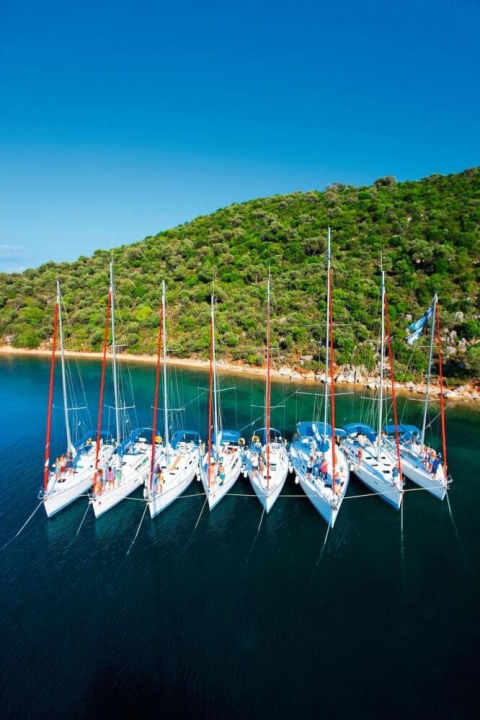
How to perform the manoeuvre
First, the crew of one vessel deploys the anchor and all fenders to the side before the neighbouring vessel performs the same manoeuvre in parallel. Then deploy the fore and aft lines and the corresponding springs. It is important that both ships deploy as much chain as possible in the same direction.
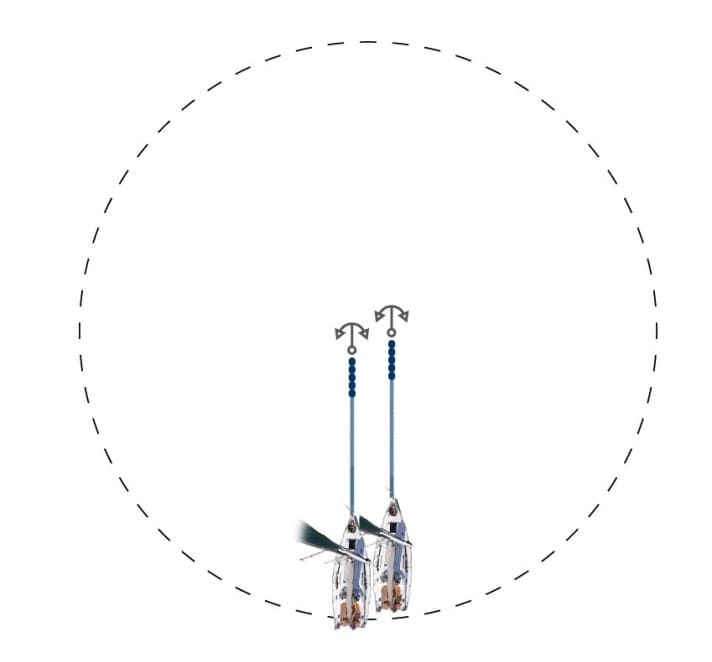
If the angle of pull and chain length are very different, one iron can break out. If both ships are then hanging on just one anchor, it is only a matter of time before it breaks away. The bay should therefore be sheltered and the wind should not be too strong.
Four special methods
Special circumstances require special measures to ensure a calm and safe anchorage. Indications in the nautical chart such as a stony bottom, rapidly falling water depths or extensive shallows are not necessarily a reason to refrain from anchoring. Otherwise, parts of the archipelago or large areas of Turkey, for example, would be virtually unknown to sailors.
Some special techniques also allow you to lie calmly where there is no shallow, sandy bay. However, as weather changes can quickly lead to dangerous situations due to the proximity of land, an anchor watch should always be organised in appropriate conditions. Another special manoeuvre is dropping the anchor single-handed. Anyone who has ever observed this manoeuvre in perfect execution will not be able to suppress a little nautical envy.
Country linen
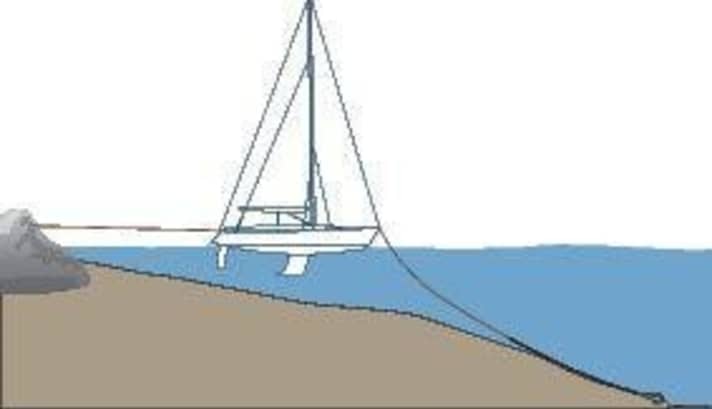
1. deploy bow anchor
A method for steeply sloping ground, as is often the case in Turkey. The anchor is deployed at a depth that is just compatible with the length of the harness. The anchor often holds very well because it is pulled "uphill" at a favourable angle. However, if the yacht turns into the low area, as is always the case with offshore winds, the anchor quickly breaks free.
2. deploy shore lines
In order to avoid this, shore lines are deployed to prevent the yacht from swinging around and to keep the anchor gear under tension. The shore lines can either be deployed from the yacht by dinghy or by swimming. However, it is easier to drive ashore with the dinghy first, attach the line there and return to the yacht with it in the dinghy.
Archipelago
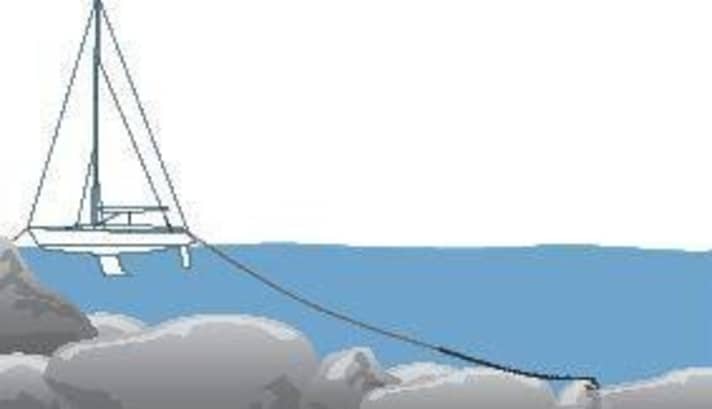
1. deploy bow anchor
A method for steeply sloping ground, as is often the case in Turkey. The anchor is deployed at a depth that is just compatible with the length of the harness. The anchor often holds very well because it is pulled "uphill" at a favourable angle. However, if the yacht turns into the low area, as is always the case with offshore winds, the anchor quickly breaks free.
2. deploy shore lines
To avoid this, shore lines are deployed to prevent the yacht from turning round and swinging and to keep the anchor gear under tension. The shore lines can be deployed either from the yacht by dinghy or by swimming. However, it is easier to go ashore with the dinghy first, attach the line there and return to the yacht with it in the dinghy.
Rear anchor
1. deploy bow anchor
Sometimes a long, shallow beach drops off abruptly to greater depths - not an ideal anchorage. However, if you still want to stay, even if only for a swim, you need a stern anchor instead of a shore line. The bow anchor is deployed in the deep area and holds very well as it pulls "uphill".
2. deploy stern anchor
The stern anchor can be brought out with the yacht or dinghy and prevents the yacht from drifting into the deep area. If the second anchor is brought very far into the shallows, it sometimes has to be dug out by hand.
One-handed
1. drop anchor over the stern
An elegant swing that not only single-handed sailors should master. The anchor should not be used with a full chain, as there is a risk of scratching the hull. The chain leader should be stowed in a bucket at the stern. The end of the hawser is tied to the bow and led outboard to the stern. The helmsman drops the anchor at the stern and fastens the leader and hawser.
2. bury anchor
If the harness is long enough, you attach the hawser to the stern and wait until the wind pressure has dug the anchor in. You can help with the engine and have very good control over the yacht, as the rudder blade is being driven by the propeller.
3. turning
The hawser at the stern is released, the stern swings round and the yacht now hangs with its bow in the wind.

